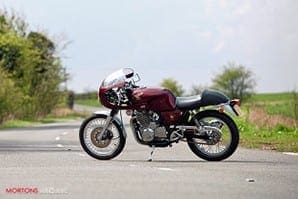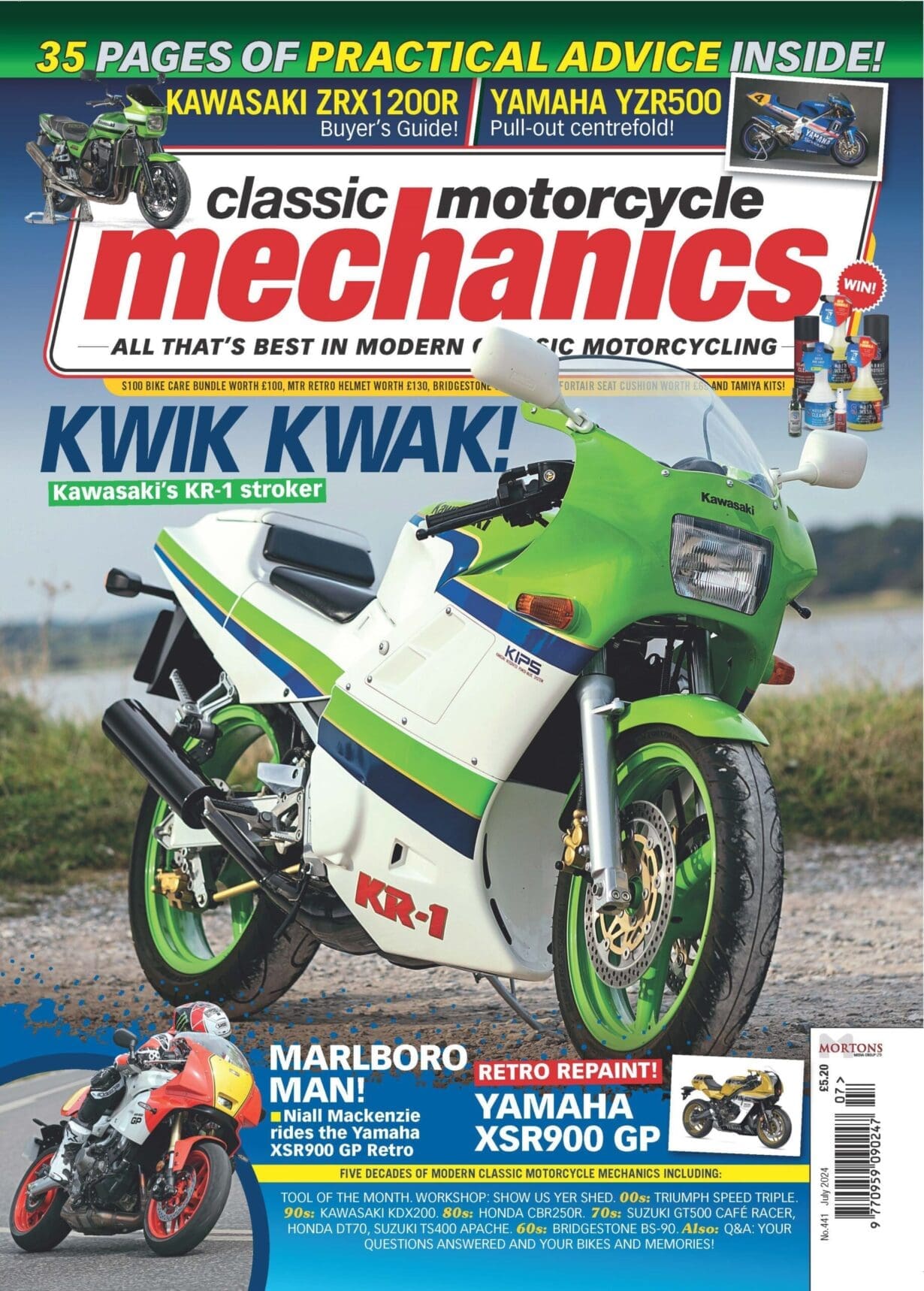
Bwooaarr, first, bwooaarr, second, bwooaarr, third. Etc, etc. It doesn’t take long to use all the gears on Honda’s GB500TT, and like most big singles it runs out of revs before you run out of expectation.
The surprising thing about this one though is how quickly you can be going when you do take your eyes off the road and glance down at the speedo. The GB makes the most of its 44bhp and makes you smile while you’re at it. This isn’t a machine for serious, beard-stroking enthusiasts, it was designed and built to let Japanese teenagers play Mountain-Mile Heroes on the streets of Tokyo.
Depending on your standpoint, this bike is either a half-baked BSA Gold Star copy or a surprisingly authentic tribute built by affectionate enthusiasts. I prefer the latter. It’s something of a long standing myth that the Japanese built their motorcycle empires by copying the British, but it doesn’t stand up to scrutiny. Kawasaki might have copied a BSA twin, but have a look through Honda, Suzuki and Yamaha’s back catalogues and you’ll see fresh thinking, innovation and remarkably few Brit-a-likes.
 Which wasn’t to say that the Japanese engineers weren’t fans of what we were doing. And, while the early days were all about revs, noise and mostly two-stroke performance, by the mid 1970s there were a handful of big, thumping singles appearing. Firstly they were in dirt bikes. Two-stroke and four-stroke, but it didn’t take long until some bright spark at Yamaha wanted to build a road bike.
Which wasn’t to say that the Japanese engineers weren’t fans of what we were doing. And, while the early days were all about revs, noise and mostly two-stroke performance, by the mid 1970s there were a handful of big, thumping singles appearing. Firstly they were in dirt bikes. Two-stroke and four-stroke, but it didn’t take long until some bright spark at Yamaha wanted to build a road bike.
By the middle of the 1980s Japan’s economy was booming, the motorcycle makers were cash rich and developing new models like there was no tomorrow. Export markets wanted bigger, faster sportier machines but Japan’s own riders were looking westward… and backwards.
Honda and Yamaha reached the same conclusions at about the same time releasing the XBR500 (Honda) and SRX600 (Yamaha) within months of each other. Both used a dry sump, four valve motor in a simple, twin shock chassis. The Honda was the more conventional and more of an all-rounder and was the better bike for most people (crucially, it had an electric start as well as a kicker – most likely as a legacy of the FT500 which quite often had neither) but to me the Yamaha looked so much nicer – a proper cafe racer.
 Honda’s response (for the Japanese market, anyway) was a limited run GB-TT model with a whole load of subtle changes and some not-so-subtle ones too like the smaller, more classically-styled tank, narrower front tyre, a very cool single seat unit, spoked wheels to replace the second-generation Comstars (which looked a little too much like those on your brother’s CB125 Superdream), fork gaiters, a painted steel mudguard and a two-into-one exhaust instead of the XBR’s twin silencers. The Japanese home market got a 400cc version (Japanese licence restrictions meant 400cc bikes were as big as most could ride), but they also built a 500cc for some export markets.
Honda’s response (for the Japanese market, anyway) was a limited run GB-TT model with a whole load of subtle changes and some not-so-subtle ones too like the smaller, more classically-styled tank, narrower front tyre, a very cool single seat unit, spoked wheels to replace the second-generation Comstars (which looked a little too much like those on your brother’s CB125 Superdream), fork gaiters, a painted steel mudguard and a two-into-one exhaust instead of the XBR’s twin silencers. The Japanese home market got a 400cc version (Japanese licence restrictions meant 400cc bikes were as big as most could ride), but they also built a 500cc for some export markets.
This example here has been extensively restored and modified to make it even more of an authentic cafe racer. It took a lot of work to fit that sleek half fairing. Brackets were fabricated, headlamp moved, indicators replaced with neat button items. The clip on bars now sit below the yokes and a couple of neat bar end mirrors give a decent view behind.
Starting is simple even without the electric foot. A compression ratio of just 8.9:1 plus an automatic valve lifter means it usually goes first kick. The chunky looking XBR engine was all new in 1985 and used a gear driven balance shaft to add a little refinement and smoothness – Honda’s engineers might have admired the Brits, but they couldn’t stop themselves building a Honda.
The short stroke engine was built to rev but peak power was just 7800rpm – not that far ahead of its 30-year-old British ancestors. And peak torque was at a whopping (for a single) 6000rpm. Such a short stroke gave a huge bore of 99mm which gave plenty of room for four valves, and in  further tribute to the golden era of British bikes, Honda used radial valves as used on the pre-war Rudge racers to make most use of the available space. Fuel was supplied by a 39mm CV carb and claimed power was 44bhp – which was three more than a Velocette Thruxton Venom.
further tribute to the golden era of British bikes, Honda used radial valves as used on the pre-war Rudge racers to make most use of the available space. Fuel was supplied by a 39mm CV carb and claimed power was 44bhp – which was three more than a Velocette Thruxton Venom.
Once running it needs a long while to get properly warmed up and is prone to the occasional stall at tickover (a well known XBR foible). Better to just start it and ride it, that way it warms up faster. Setting off is simple. The clutch is light, gearbox too, and power comes in smoothly and gently in a linear fashion. It still feels like a modern engine – very free revving – without the restriction of the modern single’s emission equipment.
Top speed on a standard XBR is either 90mph or 110mph depending on which way the wind is blowing. Our entirely unscientific test suggests that the aftermarket fairing adds around 10mph to that number and evens out the effects of a headwind. And being frame mounted, the spacious-but-lightweight bodywork doesn’t affect the stability at high speed. It’s a very cool-looking and effective conversion and a credit to the previous owner who fabricated it.
So the GB is good. Very good. And while an interesting afternoo n spent riding a Gold Star and Velocette Venom with our sister title Classic Bike Guide showed that it might not quite be the authentic ‘Ace Caff’ experience, in some respects it does come very close. And the comparison is a little unfair anyway. It’s like putting your local barmaid in a beauty contest with the memory of Marilyn Monroe. The legend says Norma Jean was untouchable, but truth is, in the flesh, Angie from the Mason’s Arms might be the better, er, ride (ah, the perils of a bad mixed metaphor. Sorry, did I just say that out loud?). Besides, a decent Gold Star is approaching £15,000 these days and a Venom will cost you £10k. A good XBR can still be had for less than £2000 and even an absolutely mint GB like this one (surely the most desirable of the XBRs) will only set you back £4-5000k.
n spent riding a Gold Star and Velocette Venom with our sister title Classic Bike Guide showed that it might not quite be the authentic ‘Ace Caff’ experience, in some respects it does come very close. And the comparison is a little unfair anyway. It’s like putting your local barmaid in a beauty contest with the memory of Marilyn Monroe. The legend says Norma Jean was untouchable, but truth is, in the flesh, Angie from the Mason’s Arms might be the better, er, ride (ah, the perils of a bad mixed metaphor. Sorry, did I just say that out loud?). Besides, a decent Gold Star is approaching £15,000 these days and a Venom will cost you £10k. A good XBR can still be had for less than £2000 and even an absolutely mint GB like this one (surely the most desirable of the XBRs) will only set you back £4-5000k.
Ridden in isolation the Honda is lovely. It has all the feel and character of a proper one-lung road burner with gutsy power that comes in a short, sharp rush and a slick gearbox that lets you use it. The riding position is authentic without being extreme and the pretty half fairing does a good job of keeping the wind off at speed. That small, sculpted nose cone makes the Honda feel longer than it is and exaggerates the stretched out riding position, especially when you get flat on the tank, with your backside over the rear wheel for those extra few mph.
I’d swear that the Brits we rode were faster though, but it’s not true. Definitely more gutsy and much more torquey as you might expect from their long stroke motors, but the Honda builds revs quickly and in a couple of impromptu drag races it was quickest every time. But not by very much.
were faster though, but it’s not true. Definitely more gutsy and much more torquey as you might expect from their long stroke motors, but the Honda builds revs quickly and in a couple of impromptu drag races it was quickest every time. But not by very much.
What I really liked about this bike though was how the handling felt authentic too. By which I mean that it bucks, weaves and bounces around on soft suspension without ever getting scary. I’m not sure whether that’s a criticism or not. You could quite easily sort the suspension and make it handle like a scalpel, but for me, that’s not the point. The fun and the appeal of this bike is that it gives the classic experience without the high entry costs and maintenance or reliability worries. This little Honda will run and run. I could, and would, ride it everywhere. Honda’s engineers did a good job with their Brit bike tribute, just like Kawasaki’s chaps did a cracking job with the W650 and W800 twins. It’ll never match the real thing(s) of course, but if you fancy a daily rider with all the character and fun of a Goldie, you’d be hard pressed to find something better. ![]()












